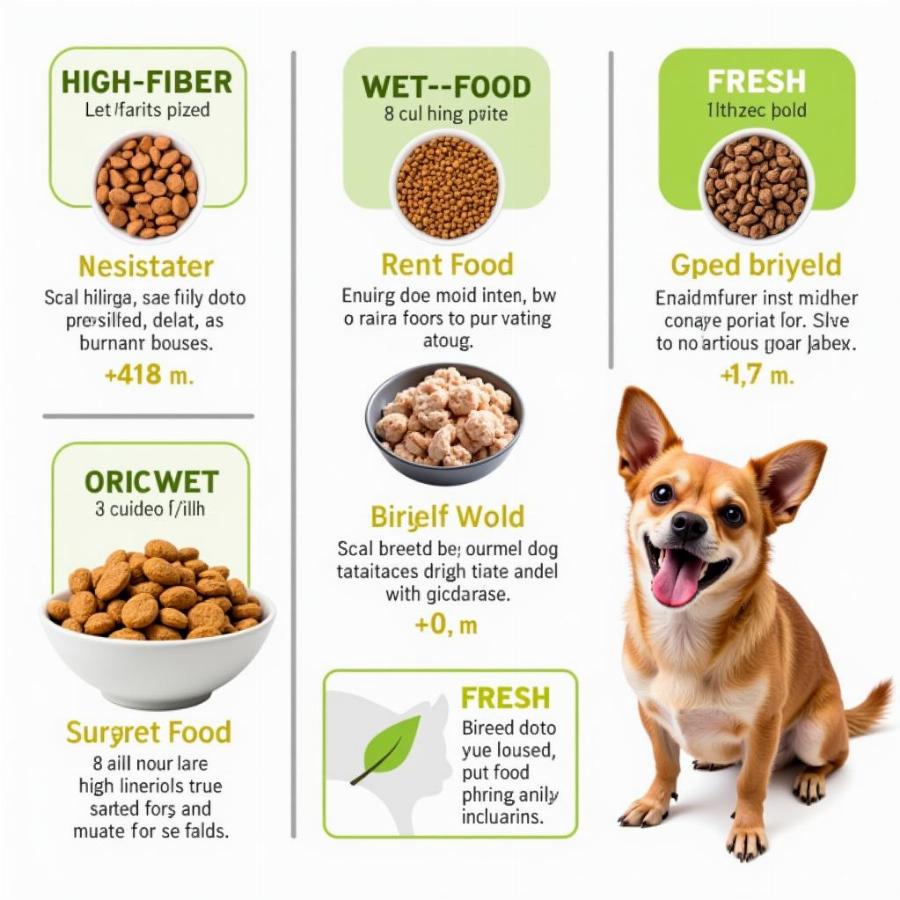High fiber dog food can be a game-changer for small breeds experiencing digestive issues. From promoting healthy bowel movements to aiding in weight management, a diet rich in fiber offers numerous benefits. This guide explores the importance of high fiber dog food for small breeds, helping you make informed choices for your furry friend.
Why is Fiber Important for Small Breed Dogs?
Fiber plays a crucial role in a small dog’s digestive health. It adds bulk to the stool, preventing constipation and diarrhea. It also helps regulate blood sugar levels, which is particularly important for small breeds prone to diabetes. Additionally, high fiber diets can contribute to weight management by promoting satiety, preventing overeating. For small dogs with sensitive stomachs, fiber can be incredibly beneficial in easing digestion and preventing discomfort.
 High Fiber Dog Food for Small Breeds
High Fiber Dog Food for Small Breeds
Choosing the Right High Fiber Dog Food
When selecting a high fiber dog food for your small breed, consider the following factors:
- Fiber Source: Look for natural fiber sources like beet pulp, brown rice, and fruits and vegetables. Avoid artificial fillers.
- Fiber Content: Check the guaranteed analysis on the label. Aim for a diet with a moderate fiber content, typically between 4-8%.
- Ingredients: Choose foods with high-quality, digestible ingredients. Avoid artificial colors, flavors, and preservatives.
- Calorie Content: Small breeds have higher metabolic rates. Ensure the food provides adequate calories for their energy needs without being too calorie-dense.
Benefits of High Fiber Dog Food for Small Breeds
Improved Digestive Health
High fiber dog food helps regulate bowel movements and can alleviate both constipation and diarrhea in small breeds. It promotes a healthy gut environment and can reduce the risk of digestive issues.
Weight Management
Fiber helps small dogs feel fuller for longer, reducing their tendency to overeat. This can be particularly helpful for small breeds prone to obesity.
Blood Sugar Regulation
Fiber helps stabilize blood sugar levels, making it beneficial for small breeds prone to diabetes or those requiring weight management.
How to Transition to a High Fiber Diet
Transition gradually to avoid upsetting your dog’s stomach. Start by mixing a small amount of the new high fiber food with their current food. Gradually increase the proportion of high fiber food over several days until they are eating it exclusively. Monitor your dog for any digestive upset during the transition.
What are the signs my small dog needs more fiber?
Is your small dog experiencing frequent constipation or diarrhea? Are they struggling with their weight? These could be signs that they would benefit from a high fiber diet. Consult your veterinarian to determine the right approach for your dog’s individual needs.
What if my dog experiences digestive upset after switching to high fiber food?
If your dog experiences gas, bloating, or diarrhea after switching to high fiber food, it may be a sign that the transition was too rapid. Try slowing down the transition process or consult your veterinarian.
Conclusion
Choosing a high fiber dog food can significantly improve the digestive health and overall well-being of your small breed dog. By carefully considering the fiber source, content, and ingredients, you can ensure your furry companion receives the nutrition they need to thrive. Remember to consult your veterinarian before making any significant dietary changes, especially if your dog has pre-existing health conditions. High fiber dog food can be a valuable tool in promoting a long, healthy, and happy life for your small breed companion.
FAQ
-
What are some good sources of fiber for small dogs? Beet pulp, brown rice, pumpkin, and sweet potatoes are excellent sources of fiber.
-
Can puppies eat high fiber dog food? Consult your veterinarian before giving a puppy high fiber food, as their nutritional needs are different.
-
How much fiber does a small dog need? The ideal fiber intake varies depending on the individual dog’s needs. Consult your veterinarian for guidance.
-
What are the signs of too much fiber in a dog’s diet? Excessive gas, bloating, and loose stools can indicate too much fiber.
-
Are there any risks associated with high fiber dog food? In some cases, excessive fiber can interfere with nutrient absorption. Consult your veterinarian to ensure the diet is appropriate for your dog.
-
Can I add fiber supplements to my dog’s food? Consult your veterinarian before adding any supplements to your dog’s diet.
-
What types of high-fiber dog foods are available for small breeds? Many high-fiber dry kibble, wet food, and fresh food options are available. Look for brands that cater to small breed needs.
Do you have other questions about your dog’s health? Check out our articles on how to clean dog vomit out of carpet and can dogs eat apricots. You might also find our article on best dog food for labrador retriever puppy helpful if you’re considering adding a new member to your family. If you’re wondering what age is a dog a senior, we’ve got you covered there too.
Beaut Dogs is your trusted source for expert advice on all things dog-related. We provide comprehensive information on choosing the right breed, nutrition, training, and overall care for your canine companion. For personalized guidance, reach out to our team of experts via Email: [email protected]. We’re here to help you provide the best possible care for your furry friend.